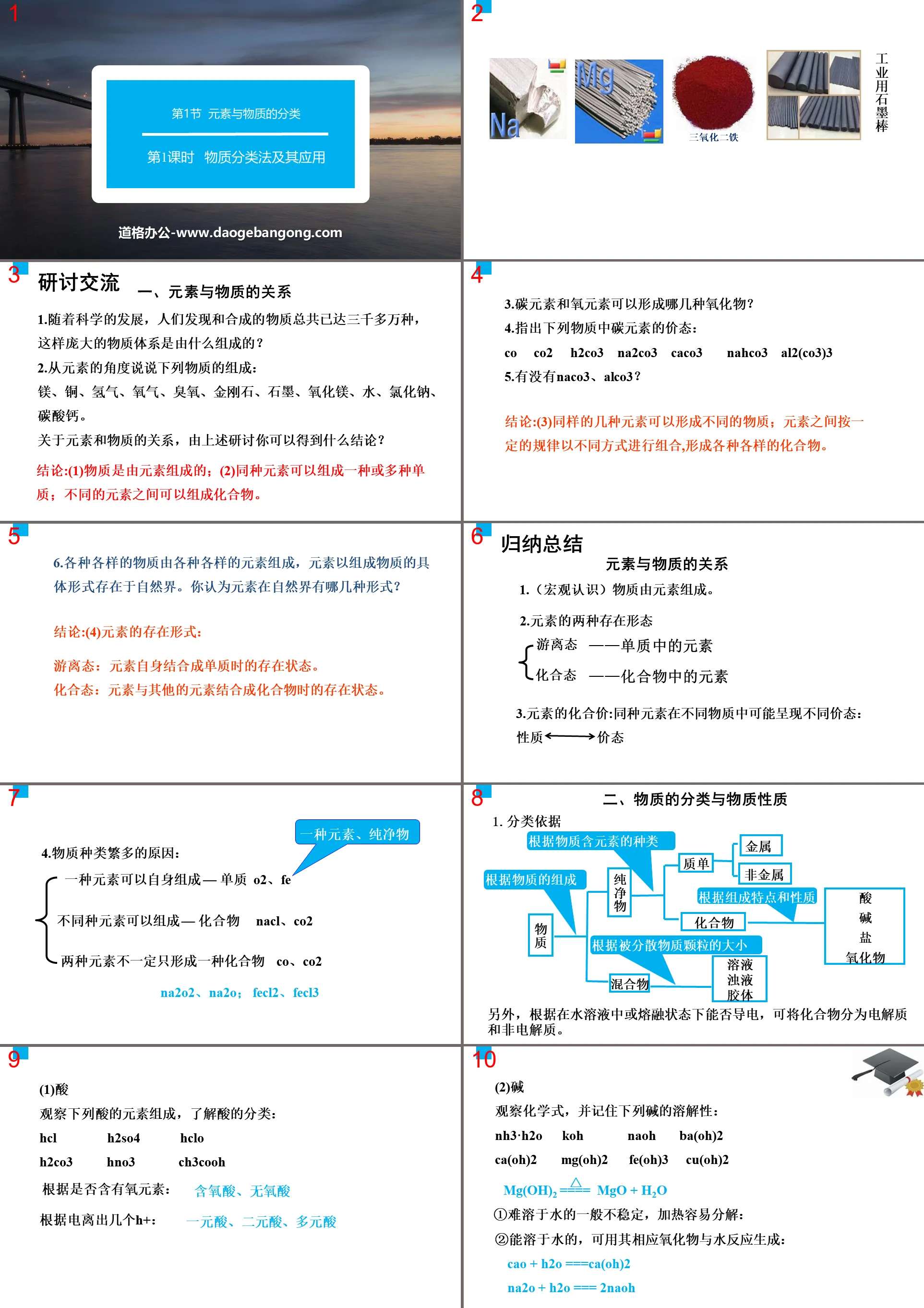People's Education Press High School Chemistry Compulsory Course I
Cantonese Education Edition Ninth Grade Chemistry Volume 1
Beijing Curriculum Reform Edition Ninth Grade Chemistry Volume 1
People's Education Press Ninth Grade Chemistry Volume 1
Beijing Curriculum Reform Edition Ninth Grade Chemistry Volume 2
Lu Jiao Edition Ninth Grade Chemistry Volume 1
Lu Ke Edition High School Chemistry Compulsory Course 1
Hunan Education Edition Ninth Grade Chemistry Volume 1
Cantonese Education Edition Ninth Grade Chemistry Volume 2
People's Education Press Ninth Grade Chemistry Volume 2
People's Education Press High School Chemistry Compulsory Course 2
Hunan Education Edition Ninth Grade Chemistry Volume 2
Lu Ke Edition High School Chemistry Compulsory Course 2
Lu Jiao Edition Ninth Grade Chemistry Volume 2

| Category | Format | Size |
|---|---|---|
| Lu Ke Edition High School Chemistry Compulsory Course 1 | pptx | 6 MB |
Description
"Classification of Elements and Matter" Elements and the Material World PPT (Lesson 1 Material Classification and Its Application)
Part One Content: Discussion and Exchange
1. The relationship between elements and matter
1. With the development of science, people have discovered and synthesized more than 30 million kinds of substances. What does such a huge material system consist of?
2. Discuss the composition of the following substances from the perspective of elements:
Magnesium, copper, hydrogen, oxygen, ozone, diamond, graphite, magnesium oxide, water, sodium chloride, calcium carbonate.
Regarding the relationship between elements and matter, what conclusions can you draw from the above discussion?
Conclusion: (1) Matter is composed of elements; (2) The same element can form one or more simple substances; different elements can form compounds.
3. Which oxides can be formed by carbon and oxygen?
4. Indicate the valence state of carbon in the following substances:
CO CO2 H2CO3 Na2CO3 CaCO3 NaHCO3 Al2(CO3)3
5. Is there NaCO3 or AlCO3?
Conclusion: (3) The same elements can form different substances; elements are combined in different ways according to certain rules to form various compounds.
6. Various substances are composed of various elements, and elements exist in nature in the specific form of composing substances. What forms do you think elements have in nature?
Conclusion: (4) The existence form of elements:
Free state: The state of existence when an element combines itself to form a single substance.
Combination state: The state of existence of an element when combined with other elements to form a compound.
In conclusion
The relationship between elements and matter
1. (Macroscopic understanding) Matter is composed of elements.
2. Two forms of existence of elements
Free state - elements in simple matter
Combined state – elements in a compound
3. Valence of elements: The same element may show different valence states in different substances: Properties - Valence state
4. Reasons for the wide variety of substances:
An element can form itself - elemental O2, Fe
Different elements can be made up - compounds NaCl, CO2
Two elements do not necessarily form only one compound CO, CO2
2. Classification of substances and properties of substances
1. Classification basis
In addition, compounds can be divided into electrolytes and non-electrolytes based on whether they can conduct electricity in an aqueous solution or in a molten state.
(1)Acid
Observe the elemental composition of the following acids to understand the classification of acids:
HCl H2SO4 HClO
H2CO3 HNO3 CH3COOH
According to whether it contains oxygen element: oxyacid, anaerobic acid
Several H+ are produced according to ionization: monobasic acid, dibasic acid, polybasic acid
(2)Alkali
Observe the chemical formula and remember the solubility of the following bases:
NH3·H2O KOH NaOH Ba(OH)2
Ca(OH)2 Mg(OH)2 Fe(OH)3 Cu(OH)2
①Those that are difficult to dissolve in water are generally unstable and easily decompose when heated:
② If it is soluble in water, its corresponding oxide can be reacted with water to generate:
(3)Salt
Observe the constituent elements of the following salts to understand the classification of salts:
NaCl Na2SO4 Na2CO3 KNO3 NH4Cl
(4) Oxide
Observe the constituent elements of the following oxides to understand their classification:
SO2 CO CO2 Na2O Na2O2 CuO
Oxygen and metal elements are composed of: metal oxides
Oxygen and non-metal elements are composed of: non-metal oxides
According to their properties, they can also be divided into acidic oxides and alkaline oxides.
①Acidic oxide
Definition: An oxide that reacts with a base to form only salt and water.
Properties: a. Reacts with alkali to produce only salt and water.
CO2 + 2NaOH ==== Na2CO3 + H2O
b. Most can combine with water to form acid.
CO2 + H2O ==== H2CO3
c. Most non-metal oxides are acidic oxides. CO, NO, and H2O are not acidic oxides.
Some metal oxides are also acidic oxides. Mn2O7 is an acidic oxide.
Tracking exercises
Decide whether the following statements are correct.
1. Metal oxides must be alkaline oxides. ( )
2. Alkaline oxides must be metal oxides. ( )
3. Acidic oxides must be non-metal oxides. ( )
4. Non-metal oxides are not necessarily acidic oxides. ( )
5. Compounds that can ionize H+ must be acids. ( )
6. CH3COOH is a monobasic acid. ( )
7. Compounds containing oxygen are all oxides. ( )
2. Study the properties of substances according to their categories
When studying the properties of substances according to their categories, typical representative substances are often selected for analysis;
Please work in groups to discuss the chemical properties of the following substances:
(1) Metal element (2) Oxide
(3) Acid (4) Base
(5) Salt
Classification of elements and substances PPT, Part 2 content: Class summary
1. The relationship between elements and matter
1. Matter is composed of elements
2. The reason for the wide variety of substances
3. Existence forms of elements: free state, combined state
2. Classification of substances
1.Acidic oxides, alkaline oxides
2. The relationship between elemental substances, oxides, acids, bases and salts
Classification of elements and substances PPT, Part 3: Practice in class
1. The following words are printed on the label of a certain mineral water: Main ingredients (unit: mg/L) Ca: 20.2, K: 39.1, Mg: 3.27, Zn: 0.06, F: 0.02.
"Ca, K, Mg, Zn, F" on the label refers to ( )
A.Element B.Element C.Atom D.Molecule
2.Which of the following related substances is classified or classified incorrectly ( )
A. Mixture: hydrochloric acid, pig iron, air
B. Compounds: CaCl2, NaOH, HCl
C. Salt: CaO, calcium carbonate, salt
D.Elements: He, O2, O3
3. A study group discussed and analyzed which of the following statements is correct ( )
A. Coarse salt and caustic soda are mixtures
B. Soda ash and caustic soda are both bases
C. Ice and dry ice are both pure substances and compounds
D. Hydrochloric acid and vinegar are both compounds and acids
4. Which of the following statements is correct ( )
A. Non-metal oxides are all acidic oxides
B. Any compound that can ionize H+ is an acid
C. Salt substances must contain metal elements
D. Metal oxides are not necessarily alkaline oxides
Keywords: Free download of the PPT courseware of Lu Ke Edition High School Chemistry Compulsory Course 1, PPT download of the classification of elements and substances, PPT download of elements and the world of matter, PPT download of substance classification method and its application, .PPT format;
For more information about the PPT courseware "Elements and the World of Materials, Classification of Elements and Substances, Classification of Substances and Their Applications", please click the tag of "Elements and the World of Materials, Classification of Elements and Substances, ppt Classification of Substances and Their Applications" ppt.
"Integration of this Chapter" Elements and the Material World PPT:
"Integration of this Chapter" Elements and the World of Matter PPT Part 1 Content: Breakthrough Judgment of Large Coexistence of One Ion Example 1 A group of ions that can coexist in large quantities in both strongly acidic and strongly alkaline solutions is ( ) A.Na+, Cu2+, Cl -, SO_4^2- B.K+, Ca2+, NO_3^- ..
"Integration and Improvement at the End of Chapter" Elements and Material World PPT:
"End-of-Chapter Integration Improvement" Elements and Material World PPT Part One Contents: 1. Classification methods and their application in life 1. Classification of elements and substances (1) Elements exist in nature in free and combined states, and very active elements can only exist in combined states. like..
"Micro Project Scientific Use of Chlorine-Containing Disinfectants" Elements and the World of Matter PPT courseware:
"Micro Project Scientific Use of Chlorine-containing Disinfectants" Elements and the World of Matter PPT courseware Part One: Literacy Objectives 1. Predict the properties of chlorine-containing disinfectants from the perspective of substance categories and element valences. 2. Understand the common chlorine-containing disinfectants in daily life and use redox...
File Info
Update Time: 2024-10-03
This template belongs to Chemistry courseware Lu Ke Edition High School Chemistry Compulsory Course 1 industry PPT template
"Classification of Elements and Matter" Elements and the Material World PPT (Lesson 1 Material Classification and Its Application) Simple campus recruitment activity planning plan summary enterprise and institution recruitment publicity lecture PPT template is a general PPT template for business post competition provided by the manuscript PPT, simple campus recruitment activity planning plan summary enterprise and institution recruitment promotion Lecture PPT template, you can edit and modify the text and pictures in the source file by downloading the source file. If you want more exquisite business PPT templates, you can come to grid resource. Doug resource PPT, massive PPT template slide material download, we only make high-quality PPT templates!
Tips: If you open the template and feel that it is not suitable for all your needs, you can search for related content "Classification of Elements and Matter" Elements and the Material World PPT (Lesson 1 Material Classification and Its Application) is enough.
How to use the Windows system template
Directly decompress the file and use it with office or wps
How to use the Mac system template
Directly decompress the file and use it Office or wps can be used
Related reading
For more detailed PPT-related tutorials and font tutorials, you can view: Click to see
How to create a high-quality technological sense PPT? 4 ways to share the bottom of the box
Notice
Do not download in WeChat, Zhihu, QQ, built-in browsers, please use mobile browsers to download! If you are a mobile phone user, please download it on your computer!
1. The manuscript PPT is only for study and reference, please delete it 24 hours after downloading.
2. If the resource involves your legitimate rights and interests, delete it immediately.
3. Contact information: service@daogebangong.com
"Classification of Elements and Matter" Elements and the Material World PPT (Lesson 1 Material Classification and Its Application), due to usage restrictions, it is only for personal study and reference use. For commercial use, please go to the relevant official website for authorization.
(Personal non-commercial use refers to the use of this font to complete the display of personal works, including but not limited to the design of personal papers, resumes, etc.)
Preview










